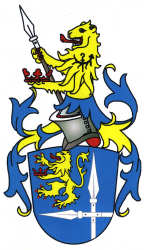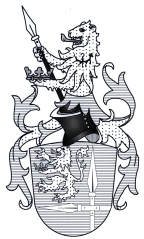| Family Tree / Descendants list Chart Domiciles / Duration of Stay / Generations |  |
| Family Coat of Arms | |
 |
 |
| The heraldic
description of the Family Coat of Arms
The description of the family coat of arms, also called "Blasonierung" is as follows: In blue on the left flank position a silvery spear coming from the low shield edge upright, crossed with a silvery spear coming from left shield edge horizontal, a red fierce and tongued erect golden lion enclosing a red coronet in the left paw. On the helmet with blue-gold decoration, the lion rampant, covered with a black brand mark, comprising a stag’s antler horizontal, crossed upright by a crook, in the right paw a black-shafted silver spear, in the left holding the red coronet.10 |
|
|
The interpretation of the coat of arms With the creation of the family coat of arms the colours used (tinctures) as well as the symbols were carefully thought out and chosen by the armorial founder. The colours, as they appear in the Wern - Wöhrn - Wörn – Woern family-coat of arms, have the following interpretation in heraldry: |
|
|
Gold (yellow) is the first of the metal colours in heraldry. Gold corresponds to the sun and reminds one of the gemstone topaz. It symbolises understanding, prestige, virtue and majesty. In black and white format its hatching is done with little dots.Silver (white) is the second of the heraldic metal colours and is assigned to the moon and pearls. Its symbolism is wisdom, innocence and joy. There is no hatching. Red is the first colour in heraldry and is attributed to the planet Mars and the gemstone ruby. The symbolism is the quest to make oneself worthy of one’s homeland. Its hatching is with vertical lines. Blue is the second colour in heraldry. It stands for the planet Jupiter and the gemstone sapphire, denoting fidelity and constancy and is hatched horizontally. Black is the third colour in heraldry and stands for the planet Saturn and the gemstone diamond. Its symbolism is mourning. The hatching is either a combination of horizontal and vertical lines or soft black print. In the Middle Ages and in early modern times, emotional values were generally connected to colours, which admittedly no longer play a role in modern heraldry, but which are still anchored in popular belief. The assignment of the stars, planets and gems comes from the same period.11 The founder of the Wörn coat of arms wanted the relevant pictures and figures to be interpreted as follows: The crossed spears in the escutcheon refer to the original meaning of the surname, which reflected the pugnaciousness and readiness of the bearer to protect himself from anything which needed defending or, in the figurative sense, to face up to an idea. The lion in the escutcheon means two things. As king of the animals, it is from time immemorial the sign of sovereign-like force and symbol for courage, bravery and fighting strength. However, it also stands for the idea for which the bearer of the coat of arms places himself ready to fight. The lion displays a coronet so to speak as the prize for a battle won or as a symbol of the goal to be attained as the object of his zeal. The protective, angular helmet became established in the 15th century as the helmet for coats of arms. The helmet covering retains the main colours of the escutcheon and was originally only a coloured cloth covering the helmet neck. In the helmet decoration, the attributes of the spear, lion and coronet recur. Additionally, in the lion’s mane, there appears a branded crook crossed by a stag’s antler. Both are to remind one of the fact that the earliest family representatives were fief-holders from the Alpirsbach cloister and the Württemberg sovereigns and as such were obliged to show special loyalty to both. In keeping with the tradition of decoration awards to knights, military symbols are now allowed to be used in coats of arms today. Professional soldiers, for example, are permitted to show the award of the Iron Cross on the collar of the helmet. As the family coat of arms alludes to the family history by its image as well as by its name, it is regarded as a so-called "speaking coat of arms". As an additional part of a coat of arms, the heraldic decorative pieces such as the motto (slogan) are shown on strips under the foot of the shield. Mainly Latin phrases are chosen. The Karl Wörn coat of arms had the following Latin motto: "Suaviter in modo, fortiter in re", which freely translates as: "Pleasant of manner, but firm in a cause". The author has also added for himself the Latin motto "Semper acer" which means something like "Always aggressive or astute". The attachment of a year number under the surname relates to the age of the recorded family history.
|
|